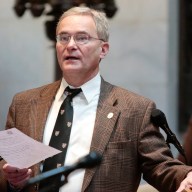EDMONTON – The Alberta government is pushing ahead with deep budget cuts as it struggles to reduce a record deficit – an unfamiliar diet after a decade of spending fuelled by booming energy royalties.
“We were at the all-you-can-eat buffet for 10 years and Albertans were lined up with us,” Treasury Board President Lloyd Snelgrove said Thursday.
“Maybe we didn’t use as much prudence as we should have in growth, but I can’t do anything about that,” he told a news conference in Calgary.
“I can tell you going forward, it is not going to happen again.”
The second-quarter fiscal update released Thursday pegs Alberta’s deficit this year at $4.3 billion, down significantly from early projections of nearly $7 billion.
Most of the turnaround is linked to a $3-billion increase in forecasted revenues since the first quarter. The extra money is coming from higher oil prices and a boost in corporate income tax and investment returns.
The update also outlines vague “value review” savings of $430 million from hiring freezes and cuts to discretionary spending for most government departments. Finance officials didn’t provide specifics.
The arithmetic the government is using to reduce the deficit hasn’t impressed the Canadian Taxpayers Federation.
“If it wasn’t for higher corporate tax revenues and higher returns on the heritage fund, the deficit would have hardly changed from the first quarter,” said federation spokesman Scott Hennig.
He noted that while the government found $430 million in savings, overall expenditures are still projected to rise by $575 million this year.
“Even when they are supposed to be cutting, they can’t keep themselves from increasing spending.”
Snelgrove said the Conservative government has managed to bring down the deficit without major job or program cuts.
Liberal Opposition Leader David Swann scoffed at Snelgrove’s suggestion that most Albertans have hardly noticed the budget cuts.
“There’s already evidence that there are tremendous losses in the health-care system,” said Swann. “We can’t cope with the extra demands of the H1N1 pandemic.
“Teachers are scrambling with larger class sizes and we’ve seen cuts to children’s services. It’s false to say this is not impacting people directly.”
But the largest cuts have yet to come.
Snelgrove confirmed that $2 billion will be trimmed from next year’s budget – split evenly between programs cuts and fewer building projects.
“I can’t say it won’t have any impact. I mean $2 billion is a pretty big chunk of change.”
The minister offered only a broad outline of the cuts. Up to 1,000 government jobs will not be filled as people retire. Delivery of social programs will be streamlined by “shrinking the government bureaucracy in the middle.”
Grants will also be reviewed, including how much charities get from gaming revenues. The amount of government office space will be reduced in the hope of saving $100 million.
Cheaper construction costs and better use of government resources, such as engineers on construction projects, is expected to save $380 million.
Finance Minister Iris Evans said Albertans will have to wait until the next budget in February to hear specifics.
“We can’t just cross our fingers and hope things will get better,” said Evans. “We have to take action, and we are.”
The government also revealed plans to borrow $1.2 billion to cover its obligations to the teachers’ pension fund rather than use $17 billion in cash reserves in the Sustainability Fund.
Total spending for the current fiscal year is now projected at $37 billion, while revenue is forecast at $32.6 billion.
The Heritage Savings Trust Fund was reported to have a “fair value” of $14.5 billion after earning $1.9 billion over the first half of the year.














